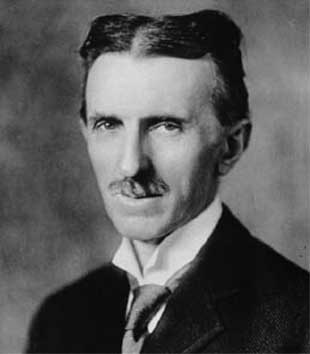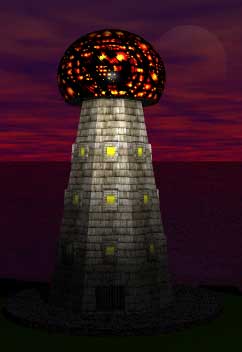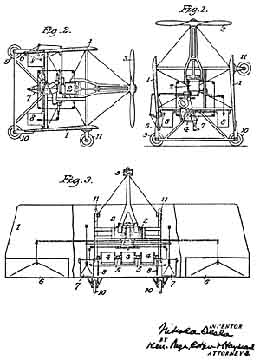|

Nikola
Tesla at age sixty-four.
|
Sorcerer
of Lightning: Nikola Tesla
During the first half of his life,
Nikola Tesla invented the AC motor, radio, remote control, and
harnessed the power of Niagara Falls. Then he formed a scheme
to deliver electrical power through the air. Would it work?
Part Two: Power
Through the Air
At his Colorado laboratory,
Tesla thought he had conquered the problems of sending electricity
through the air. This solution allowed him to envision a whole
new world with a global communication network powered by high
frequency signals.
Before he could bring this
new world into being, however, Tesla needed cash. To attract
potential investors, Tesla agreed to write a piece for Century
magazine. It was entitled "The Problem of Increasing Human
Energy" and was published in the magazine's June 1900 edition.
In it, Tesla told of his
vision for the future: the weather controlled via radio signals,
war ended because it was entirely fought by robots, the tapping
of the sun's energy via a giant antenna, and power transmitted
through the air without wires. His system, a "world wide
wireless" when "applied the earth will [allow it to]
be converted into a huge brain, capable of response in every
one of its parts," Tesla would later say. The article read
more like fiction than science, but the photos that accompanied
the article seemed even more unbelieveable.For example, one
picture showed Tesla seated at a chair in his Colorado laboratory
while streamers of high voltage electricity snaked all around
him.
Indeed, the picture seemed
incredible because it had been produced with trick photography.
The electrical bolts had been photographed in a darkened room
with a time exposure. Later, the same film was exposed again,
this time to a room with Tesla sitting quietly in a chair. When
the film was developed, it gave the impression that Tesla had
been sitting in the chair while the electrical storm raged around
him.

Artist's
conception of what the Wardenclyffe tower would have
looked like if it had ever been completed. (Copyright
Lee Krystek, 2002)
|
Wardenclyffe
The photographs and text
did their work and attracted the attention of one of the wealthiest
men of the day, J.P Morgan. Morgan gave Tesla $100,000 to develop
the "world-wide wireless" to send messages across
the Atlantic. Tesla, though, had even grander schemes than he
let on to Morgan. His wireless station would not only transmit
signals, but power.
The site chosen for his
transmission station was located on the cliffs overlooking Long
Island Sound at a place Testla called Wardenclyffe. Construction
began in 1900. The most remarkable part of the project was a
187-foot-tall tower topped with a fifty-five-ton sphere made
of steel. Beneath the tower, sixteen iron pipes were driven
three hundred feet into the earth. The construction costs quickly
exceeded the money provided by Morgan, however, and the financier
was reluctant to give any more.
Morgan was further convinced
that additional financing was not warranted when on December
12, 1901, Marconi sent the letter "S" across the Atlantic from
Cornwall, England, to Newfoundland by wireless. Marconi's approach
was much cheaper than Tesla's and Morgan saw no reason to invest
any more in Wardenclyffe. Tesla's stock among Wall Street investors
was falling and he himself observed, ""My enemies have
been so successful in portraying me as a poet and a visionary,"
he said, "that I must put out something commercial without delay."
Tesla could not find any
more backers and most of the site's activity had to be shut
down in 1905. Newspapers referred to it as, "Tesla's million-dollar
folly." The failure of Wardenclyffe lead Tesla to a nervous
breakdown.
Ironically, the person who
lost the most in the failure of Wardenclyffe besides Tesla might
have been J.P. Morgan. Tesla's design for a multi-channel, multiplex,
wireless system was much superior to Marconi's design and probably
would have made Morgan an additional fortune if he had only
continued his investment.
Tesla's
Turbine
|
Did
Wardenclyffe Cause the Great 1908 Siberian Explosion?
In
1908 large parts of Siberia were flattened by an enormous
and mysterious explosion.
The evidence has led most scientists to suspect that
a large asteroid or comet entered the atmosphere and
exploded over that isolated region.
Some
people, however, have suggested that the explosion was
the result of an experiment by Tesla at Wardenclyffe.
The
Wardenclyffe story may have its roots in an article
published in 1908 in Wireless Telegraphy & Telephone.
In the article Tesla says that he would soon be able
to direct electrical energy "with great precision" to
any point on the globe. Perhaps, proponents of this
idea contend, he directed it to a point in remote Siberia?
As
intriguing as this story was, there was very little
happening at Wardenclyffe in 1908. While parts of the
building were still used until 1907, most of it was
shut down, and the vital equipment had been removed
several years earlier. The truth is that Tesla had no
equipment to run such a dangerous test (if indeed he
would have) at Wardenclyffe in 1908.
|
Tesla went back into the
lab in 1906. Several years of effort resulted in the Tesla turbine.
A normal turbine of that day was basically a propellor in a
housing that would spin a shaft as moving gas or liquid passed
through the housing. Tesla's design was radically different,
however. It was a series of closely-spaced discs attached to
a shaft. Gas or steam was injected between the discs, spinning
them at a high rate of speed.
The design was extremely
efficient and Tesla envisioned it driving airplanes and automobiles
as well as ships, trains and trucks. By 1913 J.P. Morgan was
dead, but Tesla was able to get a $15,000 loan from his son
to further develop the turbine. This amount, however, was not
enough money to let Tesla overcome the problems that had shown
up in the invention.
The discs in the turbine
spun so fast that they quickly became deformed from heat. Tesla
could never resolve this problem with the metals available in
those days and the promising invention had to be shelved.
Between 1905 and the beginning
of World War II, friends began to notice changes in Tesla. Perhaps
his disappointments with the Wardenclyffe project and the turbine
were some of the reasons he seemed more depressed, withdrawn
and eccentric. Visiting the local parks, he would rescue injured
pigeons and take them back to his hotel room so he could nurse
them back to health. At that time he also became more secretive
with his actual discoveries and more likely to speculate in
the press about seemingly impossible inventions and ideas.
Radar
Though some of his ideas
seemed impossible to build, quite a few would turn out to near
perfect predictions of future inventions. As far back as 1900,
Tesla had talked about the concept of using radio waves to detect
objects at a distance. "For instance, " he wrote in
an article for the magazine Century, "by their [standing
electromagnetic waves] use we may produce at will , from a sending
station, an electrical effect in any particular region of the
globe; [with which] we may determine the relative position or
course of a moving object, such as a vessel at sea, the distance
traversed by the same, or its speed." In the August 1917
issue of The Electrical Experimenter, he went on to outline
the principals of modern military radar in detail. Tesla thought
it could be used to find submarines (which turned out to be
impractical because of the great attenuation of electrical waves
as they pass though water) but a similar design would be applied
successfully to find aircraft and surface ships during W.W.II.
Iin 1934 when Dr. Emil Girardeau lead an effort to build and
install the first French radar systems, he credited Tesla, saying
the equipment was "precisely apparatuses conceived according
to the principles stated by Tesla."
In 1922, Tesla turned 65.
To some his ideas started to seem old-fashioned. By now he was
making a living as a consulting engineer, but the solutions
he delivered to his customers often seemed impractical.
In 1928 Tesla received his
last patent, number 6,555,114, for an "Apparatus For Aerial
Transportation." His idea was for a VSTOL (vertical short takeoff
and landing) aircraft of brilliant design, but unfortunately
Tesla could never raise the money to develop it.
The
Death Beam
Tesla's last major scientific
proposal, made in 1934, was his famous "death beam."
Tesla had a hatred for war, and he thought that if he could
come up with a purely defensive weapon of great power it might
be used to discourage aggression between nations. A front page
article in the New York Times on July 11 of that year was entitled,
"TESLA, AT 78, BARES NEW 'DEATH BEAM'" and told of
the inventor's proposal that would "send concentrated beams
of particles through the free air, of such tremendous energy
that they will bring down a fleet of 10,000 enemy airplanes
at a distance of 250 miles..."
Tesla envisioned a string
of power plants along a nation's coast supplying the energy
to run the beams. Since the range would be limited by the curvature
of the Earth to about 200 miles, it would be effective against
attacking aircraft and ships, but could not be used as an offensive
weapon on other country's homelands.

Plans
Tesla filed to support his patent for a VSTOL aircraft.
|
Again Tesla went to the
younger Morgan for financing, but was turned down. He tried
to interest the British government, but after the Prime Minister
Neville Chamberlain resigned, the British lost interest. Frustrated,
Tesla then sent a technical paper describing the weapon to a
number of Allied nations. The paper was entitled "New Art
of Projecting Concentrated Non-Dispersive Energy Through Natural
Media" and described what would later be termed a charged
particle beam weapon.
Most engineers of the day
considered such an invention impractical and no charged particle
beam weapon played a role in W.W.II. However, during the cold
war between the Soviet Union and the United States several decades
later, both would spend considerable time and money trying to
develop such a device.
Missing
Papers
On January 7th, 1943, at
the age of eighty-six, Tesla died in his room at the Hotel New
Yorker. The controversy that often surrounded his life did not
end with his death. Within a few hours of his passing, Tesla's
nephew, Sava Kosanovic, a Yugoslav official, arrived at his
room to find that many technical papers as well as the inventor's
black notebook were missing. The FBI investigated and later
the rest of Tesla's effects were impounded not to be released
until 1952 when some remaining papers and possessions were sent
to Belgrade, Yugoslavia, where a museum had been established
in Tesla's honor.
After the end of WW II,
copies of Tesla's papers on particle beam weaponry used by a
U.S. Airforce operation (code-named "Project Nick") also mysteriously
disappeared without a trace.
An engineer with the National
Defense Research Committee of the Office of Scientific Research
and Development analyzed Tesla's papers that were left and reached
the conclusion:
His thoughts and efforts
during at least the past 15 years were primarily of a speculative,
philosophical, and somewhat promotional character often concerned
with the production and wireless transmission of power; but
did not include new, sound, workable principles or methods for
realizing such results.
The committee could not
know what was in the missing papers, however. Did Nikola Tesla
invent some secret weapon that is still today cloaked from the
public for reasons of national security? Or if he had designed
such a weapon did he decide that this knowledge was too powerful
for anyone to possess and took the information to his grave?
We may never know.
Return
to Part I
A
Partial Bibliography
Tesla:
A Man Out of Time by Margaret Cheney, Dell Publsihing, 1983.
Tesla:
Master of Lightning, PBS webite at http://www.pbs.org/tesla/index.html
They
All Laughed by Ira Flatow, HaperPerennial 1993.
The
Life and Times of Nikola Tesla by Marc J. Seifer, Citadel
Press Book.

Copyright Lee
Krystek 2002. All Rights Reserved.